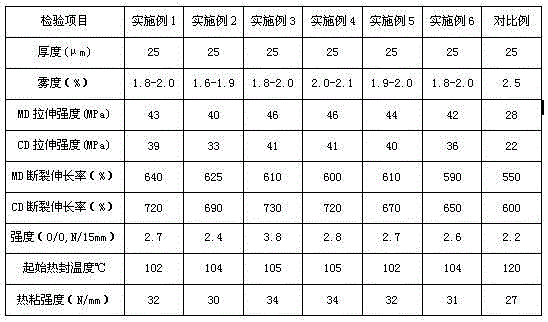CPP direct response membrane
A technology for casting polypropylene and polypropylene, applied in the field of polypropylene film, can solve the problems of poor stiffness and heat resistance, high thermal shrinkage deformation rate, unstable thermal adhesion performance, etc., to improve stiffness and temperature resistance. stability, smooth unwinding and slitting, and the effect of reducing the coefficient of friction
- Summary
- Abstract
- Description
- Claims
- Application Information
AI Technical Summary
Problems solved by technology
Method used
Image
Examples
Embodiment 1
[0019] Example 1: The casting polypropylene direct lamination film, its release layer is composed of 100 parts of polypropylene binary random copolymer resin and synthetic wollastonite release agent (10% silicon dioxide or synthetic china clay or glass microspheres and 90% polypropylene 0.002 parts of propylene blending and granulation, the same below); the core layer is composed of 100 parts of polypropylene homopolymer resin, 20 parts of ethylene-hexene copolymer, 0.1 part of dibenzylidene sorbitol nucleating agent (DBS) and mustard Amide slip agent (95% polypropylene, 5% high-purity erucamide blended and granulated, the same below) is composed of 0.0015 parts; the heat-sensitive functional layer is composed of ethylene-propylene copolymer (comonomer The content is more than 20%, the ethylene content is 8%) 100 parts, maleic anhydride grafted ethylene-octene copolymer 30 parts, ethylene methyl acrylate copolymer (EMA) 30 parts. The above-mentioned three-layer materials are ...
Embodiment 2
[0020] Example 2: The casting polypropylene direct laminating film, its anti-adhesive layer is composed of 100 parts of polypropylene binary random copolymer resin and 0.002 parts of synthetic silica; the core layer is composed of 100 parts of polypropylene homopolymer resin, ethylene-hexene copolymer 10 parts, 0.2 parts of di-p-methyl-benzylidene sorbitol (MDBS) and 0.0015 parts of erucamide slip agent; the thermosensitive functional layer is composed of 100 parts of ethylene-propylene copolymer, maleic anhydride grafted ethylene-octyl It consists of 35 parts of ethylene copolymer and 35 parts of ethylene methyl acrylate copolymer (EMA). The above-mentioned three-layer materials are melted through their respective single-screw extruders, and then formed into a film through a batching block connector, a T-die co-extrusion and casting cooling. The product is subsequently cooled and shaped, thickness tested, corona treated, rolled, aged treated, cut and packaged to obtain the ...
Embodiment 3
[0021] Example 3: The casting polypropylene direct laminating film, its anti-adhesive layer is composed of 100 parts of polypropylene binary random copolymer resin and 0.002 part of synthetic silica; the core layer is composed of 100 parts of polypropylene homopolymer resin, ethylene-hexene copolymer (comonomer content greater than 20%, ethylene content is 8%) 25 parts, di-p-chlorobenzylidene sorbitol (CDBS) 0.5 parts and erucamide slip agent 0.002 parts; heat-sensitive functional layer is composed of ethylene-propylene Copolymer (comonomer content greater than 20%, ethylene content 8%) 100 parts, maleic anhydride grafted ethylene-octene copolymer 47 parts, ethylene methyl acrylate copolymer (EMA) 18 parts, ethylene methacrylic acid (EMAA) Composition of 25 parts. The above-mentioned three-layer materials are melted through their respective single-screw extruders, and then formed into a film through a batching block connector, a T-die co-extrusion and casting cooling. The p...
PUM
 Login to View More
Login to View More Abstract
Description
Claims
Application Information
 Login to View More
Login to View More - R&D
- Intellectual Property
- Life Sciences
- Materials
- Tech Scout
- Unparalleled Data Quality
- Higher Quality Content
- 60% Fewer Hallucinations
Browse by: Latest US Patents, China's latest patents, Technical Efficacy Thesaurus, Application Domain, Technology Topic, Popular Technical Reports.
© 2025 PatSnap. All rights reserved.Legal|Privacy policy|Modern Slavery Act Transparency Statement|Sitemap|About US| Contact US: help@patsnap.com

